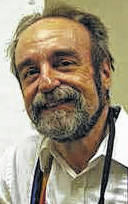
Important note: On Oct. 14, central Ohio will witness a partial solar eclipse. Eye protection, such as eclipse glasses, will be necessary to view it. Stay tuned next week for further details.
Last week, we discussed the rift among astronomers about the extent and structure of the Milky Way. That disagreement culminated in the “Great Debate” on April 26, 1920.
Harlow Shapley, of Mount Wilson Observatory, argued that the Milky Way constituted the entire universe, including the spiral nebulae, which many astronomers believed were stars coalescing.
Shapley based his argument on his previous study of the distances to the Milky Way’s globular clusters, balls of hundreds of thousands of stars that hover around our galaxy’s primary disk.
He thus estimated the primary disk’s diameter at about 300,000 light-years, an almost incomprehensibly large number. (One light year equals about six trillion miles.) How could the universe be more extensive than 300,000 light-years wide?
Lick Observatory’s Heber Curtis argued that the spiral nebulae were “island universes,: i.e., independent galaxies.
Some of Curtis’s arguments are weak because of a lack of detailed observations. For example, he noted the spiral structure of some of the nebulae. He then claimed, “There is some slight evidence for a spiral structure” of the Milky Way.
However, he admitted, “Our position near the center of the Galaxy is not a favorable one for a determination of the actual galactic structure.”
Curtis’s strongest argument boiled down to the work of Vesto Slipher at the Lowell Observatory near Flagstaff, Arizona.
Scientists have known for some time that the spectrum of a moving body is different from one at rest. If the object moves away from us, all the bands of color shift toward the spectrum’s red (low frequency) end. If it moves closer, its spectral lines shift toward the blue (high frequency) side.
Between 1912 and 1914, Slipher took the spectra of 15 galaxies. He dutifully calculated their velocities by measuring their red and blue shifts. He discovered that all but one of them was seriously red-shifted. The sheer magnitude of those shifts meant they were moving away from us at incredible velocities.
One galaxy in particular — the Sombrero near the constellation Corvus, the Crow — was moving away from our planet at the unearthly speed of 2.5 million mph, the highest known velocity of any object examined at the time.
That could not be if the nebulae were mere gas clouds in the Milky Way. They would have exited the Milky Way long ago at those unearthly speeds.
They must be far away. If they were so far, they must be the Milky Way’s size for us to see them.
That should have ended the discussion, but it didn’t. Subsequent proponents of Shapley’s point of view had to explain the reddening of the spiral nebulae’s light.
Among the most novel explanations is Fritz Zwicky’s notion of “tired light.” He argued that photons, the fundamental particles of light, lose energy. As they pass through space, they collide with other particles like photons and intergalactic dust.
As a result, some of a photon’s energy scatters into the intergalactic medium. More distant objects would appear redder than nearer objects because they pass through more intervening dust and light.
“Tired light” turned out to be a dead end. Zwicky admitted that any light scattering from distant objects should blur their images more than their actual observations.
Both Shapley and Curtis were right and wrong. Curtis was correct that the Milky Way was only one of many galaxies in an immense universe. However, he underestimated the diameter of the Milky Way at only 30,000 light-years.
He assumed that the sun was at the center of our galaxy. As subsequent data demonstrates, our daystar turns out to be about two-thirds of the way out of one of our galaxy’s spiral arms.
Shapley was fundamentally incorrect about the Milky Way’s status as the entire universe. However, he was at least in the ballpark when he estimated the diameter of the Milky Way at 300,000 light-years. Also, his globular cluster data correctly positioned the sun away from the center of the Milky Way.
Just four years later, the issue was decided once and for all by Edwin Hubble and the Hooker Telescope at Mount Wilson. More on that next week.
Tom Burns is the former director of the Perkins Observatory in Delaware.

